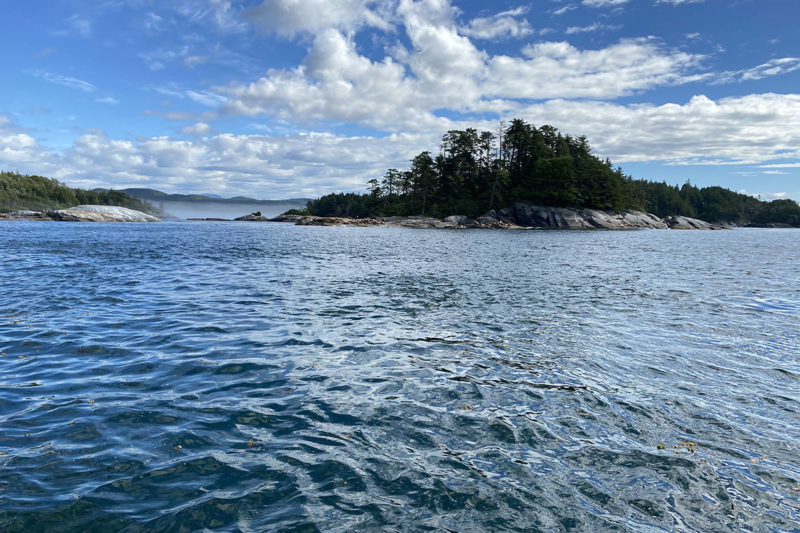Minutes away from the government dock in Port Hardy by boat, it’s easy to feel like you’ve never even heard of a city. What’s traffic? What’s stress? It’s all been blown away on the wind.
The aluminum boat skips along the clear ocean, heading to the northeast.
Tamara Keiver, a cultural language teacher during the school year and k’awat’si Tours guide by summer, points out seabirds, differentiating what look like seagulls into three distinct birds: petrels, pelagic cormorants and murres. Below them come the rhinoceros auklets, flying low to the water. These small cousins to puffins spend their days on the water diving for fish.
“Sometimes they’ll eat too much and you’ll see them skipping along the water on the way home, bouncing off their full stomachs,” Keiver laughs.
Eddie Walkus captains the boat past the Scarlett Point Lighthouse and then east towards Deserters Group of islands. ‘Nakwaxda’xw people used to meet here for summer potlatches. Clear turquoise waters are calm, protected from open ocean between the islands. Fishing is abundant even now, and the area is popular with divers.
As the story goes, the islands got their name from a crew who deserted their ship docked in Port Hardy. Supposedly, the men had heard rumours of the Cariboo gold rush, and planned to cross to the mainland, somehow working their way towards Barkerville. The captain put a bounty on their heads and recruited local ‘Nakwaxda’xw people to hunt the deserters down. They did, but the reward was slim.
Eastward, Walkus guides the boat near a stellar sea lion colony. Dozens of the golden-haired pinnipeds lie across each other, soaking up the sun, keen eyes on the tour boat. Keiver points out four giant males lounging, each on a separate rock, surrounded by their brood of females and youngsters.
“That huge one in the back with its chin straight up. If he barks, they’ll all jump into the water. Look at them waiting for his command,” she narrates.
To the right, one male sits haughtily up the rock from three smaller lions.
“Last time we were here that guy was alone, so it looks like he’s been doing well for himself.”
Walkus spots spray from a whale’s blowhole in the distance and a telltale swarm of seabirds above the water. As the boat comes closer, he points out seals feeding on the bait ball of small fish that must be below the water.
Pfuussshhhhh! — all heads turn in the direction of the whale exhaling through its blowhole. The slow, graceful arc of a humpback whale surfacing for breath, showing only its dorsal and a portion of its dark back, like the tip of an iceberg.
Humpbacks are roughly the size of a school bus. Two more slow arcs near the boat and then it casually shows its 10-foot-wide fluke as it dives deep. In another 10 minutes it might surface again.
Blunden Harbour (“Ba’as” to the ‘Nakwaxda’xw) almost directly north of Port Hardy across the Queen Charlotte Strait is the next stop, where the ‘Nakwaxda’xw lived until they were forcibly relocated to the Tsulquate reserve in Port Hardy in 1964. They, along with their northward neighbours, the Gwa’sala First Nation at Takush in Smith Inlet, were lured to Vancouver Island with false government promises of houses, schools and jobs.
In reality, there were three houses and a small school shack. The Tsulquate reserve used to be a campsite the Kwakiutl people used for clam digging. It’s rocky and exposed, not ideal for mooring boats or building houses.
The experience was traumatic. It was a deliberate strategy on the part of the government, still bent on assimilating Indigenous peoples by forcing them to give up distinct cultural practices and ways of life. While the Gwa’sala and ‘Nakwaxda’xw people visited their new home, government agents burned their longhouses and big houses to prevent them from returning.
As horrible as the recent past has been, “we’re thriving now,” Keiver says.
The k’awat’si Tours company is one of several initiatives run by Gwa’sala-‘Nakwaxda’xw First Nations’ k’awat’si Economic Development Corporation along with the Kwa’lilas Hotel. k’awat’si means bentwood box in the Kwakwaka’wakw language.
To learn more about the tours, visit https://kawatsitours.ca/.
RELATED: B.C. tourism industry seeks $680M to rebuild after pandemic
RELATED: Gwa’sala-‘Nakwaxda’xw to build new 52-spot daycare facility on reserve
Do you have something to add to this story or something else we should report on? Email: zoe.ducklow@blackpress.ca











 2020 Mission Dahlia Flower and Grape Festival celebrates the late-summer garden
2020 Mission Dahlia Flower and Grape Festival celebrates the late-summer garden